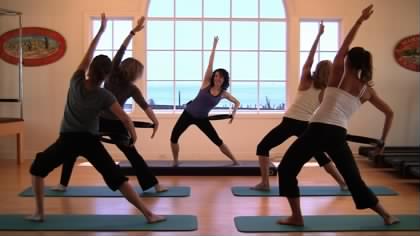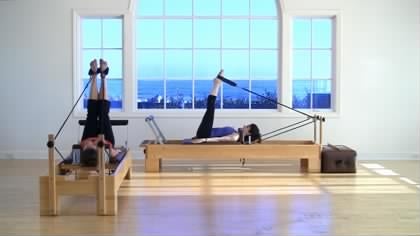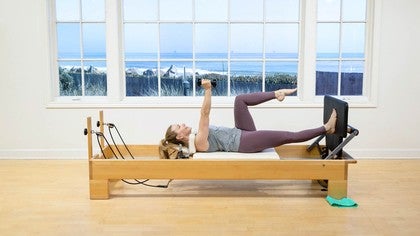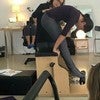Description
About This Video
Transcript
Read Full Transcript
All right. Thank you all for joining. We're going to continue where we left off with the osteoporosis safe class and now we're going to do standing work with the magic circles specifically because it's weight-bearing. One of the key components to bone building is weight bearing. It's part of the formula, so from here we're just going to bring our arms out to the sides, bring our arms all the way up to the ceiling and I'm assuming that everybody's already warm to some extent. Inhale, lift the shoulders and exhale and lower them all the way down. Good. Let's grab hold of our magic circles.
Forgive me here and what we're going to do is just a review of an exercise. It is a great way to enhance posture and to release the tightness in the back of the neck. That often occurs, and this is often what most of us are familiar with. I call it the computer slump when you sit at a computer all day, and so we're going to take our magic circle, place it behind our head. Remember it's behind the head. In other words, it's on the hair. It's not on the neck. Very, very important to to remember that you're going to gently press into your hands, resisting with your head, and we're just going to do three of these XL press and release last time. Exhale, press.
This is one of my very favorite ways to quickly engage the postural muscles. Okay? We want to make sure that we're upright and aligned before we start loading our bones, which is also the reason that it's important not to just simply start off in a standing class. It's really important, especially when we're dealing with osteoporosis. To do the portion that we did line down for us to decompress the spine. Now as I start to walk away, sorry, here we have our circles and we already revisited before the bow and arrow.
We're going to look at it a slightly different way. Right now we're gonna actually aim directly in front of us, so you're going to pull back with one hand as you push forward with the other, find your target and let's do two more exhale. So what you notice in this position is a lot of work going on behind the shoulder blades
Let's take our arms and bend our elbows here. Now I want you to bend the knees as you push one. And uh, so we're not actually working the pecs. X might work a little bit, but that is not the intention. The intention is to keep those elbows wide as opposed to here. That would be a lot more pick work. Right now I'm pushing out through my elbows while I squeeze and last time push keeping that Nice posture that we've been working.
Now bring the arms straight up overhead. Now a very gentle pressure, not too much because that could irritate anybody's shoulders if you have impingement and just a gentle push. What this does is it sets your shoulder blades so that the shoulders are relaxed. And last time, so you'll notice I'm not really moving my circle here. Now let's move the circle behind us. Now again, I could push and hunch, but that defeats the purpose. So I'm going to keep my collarbones wide and I'm going to gently press my hands into the circle. I personally don't even move my circle.
It just sets the shoulder blades and push. Now, careful also of the rib flair, soft ribs. There's so much to think about. How could you possibly get bored and last time? All right, let's bring it out to our hip. So first thing I want to do is clarify what the hip joint is. The hip is not here, we call it the hip bone, but the true hip is where the thighbone comes and meets the pelvis.
So I'm going to have you put it on the side of your hip, so not that pelvic crest, but slightly lower, and you're going to just press inwards just a little bit and press. Now, what I sense is more in my biceps here, but that may be that my arms are short. Somebody else might not experience that. Try now lifting it up onto the pelvis. You'll probably experience a little bit more obliques at this point and press. So the goal is not how hard you can squeeze the ring.
The goal is to grow taller, to experience the engagement, to experience the link. Let's try the other side. So we're going to start out on the hip here and press one and press to being cautious not to let that shoulder roll inward three. And let's do one more for now. Let's lift it up onto the pelvis and press. Every time I press I grow taller and two more press and last time press and relax.
Now let's bring it into a position between our ankles. So remember how we learned before. The way you're going to bend is you're going to bend from the knees and from the hips instead of curving through your back. So actually let's practice that for a second. Here we bend, sending our butt behind us, keeping our back straight. This is the hip hinge. We discussed this previously and rise up.
And then this is so important for the strength of your hips and you probably feel a little bit going on through your back because you're working against gravity to avoid collapsing and up and last time. All right, what would happen if we shifted our weight onto our right leg? I could hike my hip or I could let it drop. Can you see if you could let it drop and still stand tall on that other leg? Now for a little additional balance for level two, you could balance on your standing leg and squeeze in.
Squeeze in. You have other options. You could bring your arms up overhead. Squeeze in. Imagine that you're being pulled by a little string through the crown of your head. Very nice and squeeze. Let's place that foot down. Bring the hands down. Let's try the other side. So again, experience the hip hike, experienced the dropping of the hip and all of a sudden you feel this side really active. So if you'd like, try balancing on that standing leg and squeeze. Remember the ribs are soft. Squeeze if you'd like.
Bring your hands up overhead. Squeeze and squeeze. Very nice. Lower that leg. Lower your arms down. At this point I'm going to have you remove the circle. So we've just done a nice little bit of hip strengthening.
We're going to intensify it at this point. From here you can widen your feet just a little bit if you'd like, especially if you have any knee issues. The key to doing squats, which we're about to do is the knees must remain over the toes. I've had people say that their knees hurt and then I asked them to look at the positioning and it's because their knees are facing forward and their toes are facing outwards. That's a surefire recipe for disaster. So you're going to bend your knees and you're going to send your butt behind you and you're going to rise and you're going to bend. So notice this is like a hip hinge and up. Also, you want to be cautious that the knees don't come too far forward over your toes. So you really send your butt behind you, feel the glutes and rise up. Now let's make it a little bit more dynamic.
Lift the bar, uh, the circle overhead. And Return. Speed it up, circle over her head and return circle of her head and return last time. Circle overhead and return. Now from here we're going to go into a squat and we're going to come up and we're going to bring her legs together and now we're going to squat to the side, so we're going to reach out to our right and squat to the side and come together and again, squat to the side. Come together. Now you're going to take the circle and let it go out to the side as well. Circle out and in and out and and out and in.
Last time and out and in other side, ready and out and out and until we bring in additional coordination here, oh, and in two more. Out and in, out and in, and then you get your heart rate going as you can hear myself a little bit. All right, the next thing that I'd like to do, stand on your right leg. I'm going to do a little additional balance work here. You're going to reach out through your opposite leg, and I'm going to have you tap the heel down five times, four, three, two, one. Bring it out to the side out. Now go back forward and out and go back.
Forward and out and forward and out and forward. Let's try the other leg. So you're standing with your toes facing relatively forward. This is the challenge. Most people tend to be in a turnout position. The reason that I'm not having you do that is it doesn't fully access your gluteus medius muscle, which is really important for stabilizing your pelvis and for balance and tap
And come back forward and reach back alternating sides. Forgive me if I didn't say that yet. And back. Good. Collarbone, stay wide. And last time you should feel your butt by now and last time. Back and up. Very nice. Now we're going to do a little stretch here.
We're going to go into a wide stance. We're going to take our circle and we're going to place it into the hip crease. So notice where the angle changes. That's your hip crease. No, I'm to have you bend the opposite knee. So you're actually going to have, there you go. Now from here, you're gonna take your free arm up overhead and you're not going to side bend.
Instead, you're going to stay long through the waist to reach to the side of the circle, so it's a great stretch for your back. People always say, if I have osteoporosis and I'm not supposed to do a rollover, how am I going to stretch my back? There are a number of different ways. Part of back pain comes from tightness through the side, and now let's try the other side. So place your circle and the other hip crease. The beauty of this is it, it informs the muscle or made in Forbes, the bone to glide, which creates more stretch through the muscle and now free arm up. No, not a side bend, but literally as if I'm shifting my ribs toward the circle. So shift the ribs toward the circle more there.
Breathe in. Exhale. Last time. Inhale and exhale. We're going to do a quick stretch for the quads, so you're going to stand on your right leg. You're going to grab hold of the opposite ankle. Now if that is too much, you're welcome to hold on to a wall or to a chair or a table.
Now take your circle, place it against the low belly. It will inform your low belly what to do. Close Your Eyes for level two. If you want additional challenge and let's switch legs. We'll stand on the other leg. Pull the heel to the butt, pressing that magic circle against the low belly. Again, that will inform it what it needs to do. Cautious. If your knee swings out to the side that informs you.
There's a lot of tightness through your it band or through the outer part of your quad. Try and pull it inward. As long as you're not experiencing pain in the knee, close your eyes for additional challenge. So it's working. One of our three systems of balance at least one hex. I like two and lower the foot down. Last thing that we're going to do, you're going to place your circle down and I'm going to have you take a wide, once again, you're going to bend your knees and just let your shoulders be soft.
Feel the stretch on your inner thighs here. Now straighten your legs, open your hands, open your chest, squeeze your arms behind you and bring your hands forward. Lengthen through your shoulders, soft shoulders, and inhale. Bring the hands behind you. Open the chest and last time bring the arms forward. Feel the stretch of your inner thighs through parts of the hamstring. And last time, open the chest and I'll walk your feet in doing a little dance and bring your hands out in hill and exhale lower. Thank you so much for coming.
Bone Health: Osteoporosis Safe Workouts
Comments
You need to be a subscriber to post a comment.
Please Log In or Create an Account to start your free trial.



















